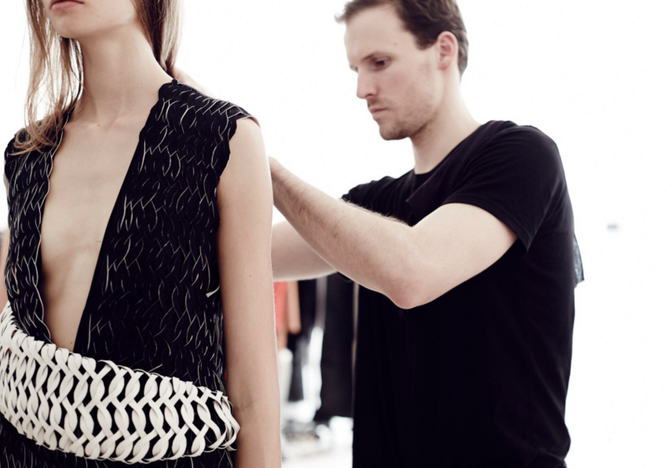Dion Lee looks back on a turbulent few years.

Words by Kelly Pigram
Photography by Saskia Wilson
Think back to 2014. It seemed like every second day, news would break of another Australian fashion designer closing their doors.
Lisa Ho, Kirrily Johnston and Josh Goot all went into voluntary administration around this time. Kit Willow was unceremoniously fired as head designer of her brand Willow, having sold a majority share to Apparel Group (which also owns Saba, Sportcraft and Jag) in 2011. Kym Ellery was involved in a heavily publicised court case against Myer. During proceedings, she admitted her business would have gone under had she not breached the contract and begun selling her designs in David Jones.
These designers were loved, but competitive international pricing, manufacturing restrictions and expensive real estate all took their toll on fashion businesses. Australia’s geographical isolation makes production costs high, and when international online retailers such as Net-a-Porter and Matches Fashion became popular in Australia, things went downhill for domestic designers.
But since 2014, Australian designers have begun to accept that an international presence is integral. Like it or not, every fashion label’s customer base is now global, which needs to be factored into businesses from the beginning.
Kym Ellery is now a permanent fixture at Paris Fashion Week, and her designs are happily stocked in both David Jones and Myer. Zimmermann, who quietly began opening standalone stores in the US while other designers struggled nationally, recently accepted a minority investment from global growth-equity firm General Atlantic. General Atlantic also invested in Uber, Airbnb and BuzzFeed in their early stages, and initiated massive growth. Cotton On, now open in 17 countries, reported a billion-dollar revenue year in 2014, while Alice McCall has expanded to China.
Dion Lee is a designer who has managed to remain unscathed while those around him struggled, and last week opened his sixth Australian retail store. In 2014 he partnered with Australian retail group Cue Clothing Company, who purchased an undisclosed share in his label and mentored his business through the unstable retail environment. Lee designed a capsule collection for Cue in 2010, and spoke of their support for his creative vision.
“I wouldn’t have really looked at any alternative investment partner in the market,” says Lee. “Retail was been accelerated by our partnership with Cue, they really helped us navigate the growth of that side of the business. They’re a company with decades of experience, to be able to tap into that within the infrastructure of the business has been really helpful.”
“[The partnership] wasn’t really related to the circumstances of what was happening in the industry at the time,” Lee says. “But our retail growth definitely wouldn’t have been possible without a strategic partner.”
Dion Lee is also now a permanent fixture at New York Fashion Week, with a loyal international following – something the label focused on developing from the beginning.
“Our first big international account was Net-a-Porter,” says Lee. “They helped us grow internationally, and to this day they’re one of our biggest international partners. Because of that account, we got a lot of support from the US press.”
Lee says the isolation of the Australian fashion industry, which seemed to be the root of most problems in 2014, is now an advantage when approaching the international market.
“I think that has created a unique Australian signature for us,” he says. “There’s an ease to our aesthetic, and a level of athleticism in our clothes that differentiates us from what you can find elsewhere.”
Lee says having a business strategy is important, but it’s secondary to having an individual voice and a product that stands out in the international market.
“International buyers see millions of collections every season,” he says. “There needs to be a sense of confidence and individuality about the brand that they can’t buy from anyone else.”
 Kym Ellery by Mike Baker
Kym Ellery by Mike Baker
 Alice McCall by Nikki To
Alice McCall by Nikki To



